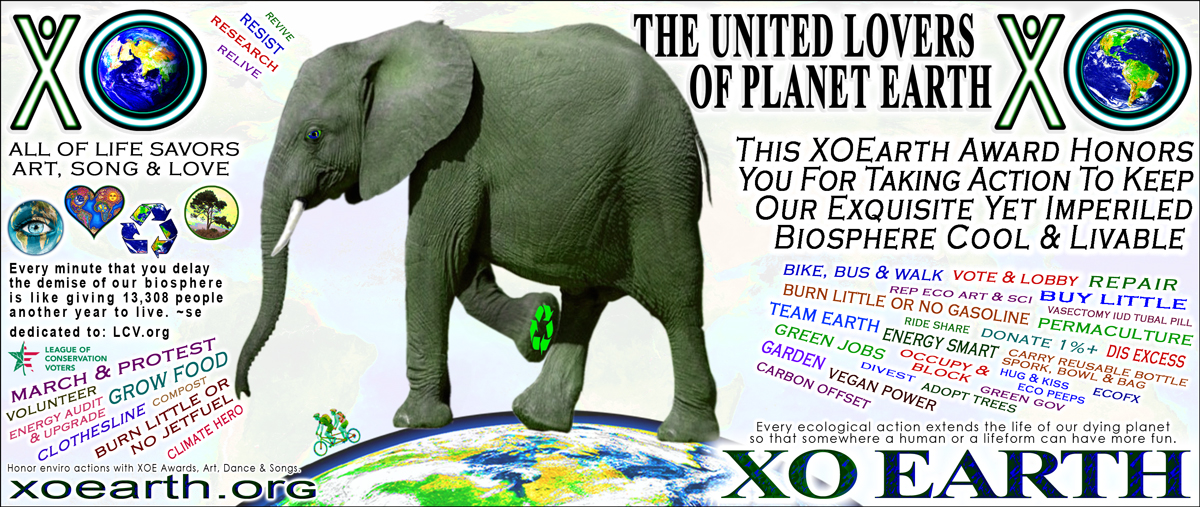

Give Elephant XOEarth Awards to eco friends and others to thank them for their past or pledged environmental actions.
Lovers of our Earth’s biosphere are invited to copy and share, or print and give, these commemorative XOEarth Awards to your government officials, friends, businesses, customers, volunteers and employees to thank them for their environmental actions – either past or pledged.
These Elephant XOEarth Awards have been dedicated to:
+ The Elephant
+ League Of Conservation Voters – LCV helps elect officials that protect the planet
+ Natural Resource Defense Fund – NRDC works to safeguard the earth — its people, its plants and animals
+ Susan Casey-Lefkowitz – NRDC Chief Program Officer 2018+
+ Rhea Suh – NRDC President 2018+
+ Joshua Axelrod – NRDC Environmental Policy 2018
+ Bill Maher – Political and environmental commentator and vegan-ish
Elephant
Elephants are of the family Elephantidae and the order Proboscidea. Three species are recognised, the African bush elephant (Loxodonta africana), the African forest elephant (L. cyclotis), and the Asian elephant (Elephas maximus). Elephants are scattered throughout sub-Saharan Africa, South Asia, and Southeast Asia. Male African elephants can reach a height of 4 m (13 ft) and weigh 7,000 kg (15,000 lb). Elephants’ large ear flaps help to control their body temperature.
Females (“cows”) tend to live in family groups, which can consist of one female with her calves or several related females with offspring. Males (“bulls”) leave their family groups when they reach puberty and may live alone or with other males. Calves are the centre of attention in their family groups and rely on their mothers for as long as three years. Elephants can live up to 70 years in the wild.
African elephants are listed as vulnerable by the International Union for Conservation of Nature (IUCN) while the Asian elephant is classed as endangered. One of the biggest threats to elephant populations is the ivory trade, as the animals are poached for their ivory tusks. Other threats to wild elephants include habitat destruction and conflicts with local people.
Elephants are herbivorous and will eat leaves, twigs, fruit, bark, grass and roots. They are born with sterile intestines and require bacteria obtained from their mother’s feces to digest vegetation. They can consume as much as 150 kg (330 lb) of food and 40 L (11 US gal) of water in a day.
Female elephants spend their entire lives in tight-knit matrilineal family groups, some of which are made up of more than ten members, including three pairs of mothers with offspring, and are led by the matriarch which is often the eldest female.
The social life of the adult male is very different. As he matures, a male spends more time at the edge of his group and associates with outside males or even other families.
Adult males enter a state of increased testosterone known as musth. The main characteristic of a bull’s musth is a fluid secreted from the temporal gland that runs down the side of his face. He may urinate with his penis still in his sheath, which causes the urine to spray on his hind legs. Behaviours associated with musth include walking with the head held high and swinging, picking at the ground with the tusks, marking, rumbling and waving only one ear at a time.
Males become extremely aggressive during musth. In contests between musth and non-musth individuals, musth bulls win the majority of the time, even when the non-musth bull is larger. A male may stop showing signs of musth when he encounters a musth male of higher rank. Agonistic encounters typically consist of threat displays, chases, and minor sparring with the tusks. Serious fights are rare.
Elephants are polygynous breeders, and copulations are most frequent during the peak of the wet season. A cow in oestrus releases chemical signals (pheromones) in her urine and vaginal secretions to signal her readiness to mate.
During copulation, the male lays his trunk over the female’s back. The penis is very mobile, being able to move independently of the pelvis. Prior to mounting, it curves forward and upward. Copulation lasts about 45 seconds and does not involve pelvic thrusting or ejaculatory pause. The penis sprays a jet of semen into the vagina without actually penetrating it. Form there, the sperm must swim close to 2 m (6.6 ft) to reach the egg. By comparison, human sperm only has to swim around 76.2 mm (3.00 in).
Homosexual behavior is frequent in both sexes. As in heterosexual interactions, this involves mounting. Male elephants sometimes stimulate each other by playfighting and “championships” may form between old bulls and younger males. Female same-sex behaviors have been documented only in captivity where they are known to masturbate one another with their trunks.
Gestation in elephants typically lasts around two years with interbirth intervals usually lasting four to five years. Calves are born 85 cm (33 in) tall and weigh around 120 kg (260 lb). Typically, only a single young is born, but twins sometimes occur. The relatively long pregnancy is maintained by five corpus luteums (as opposed to one in most mammals) and gives the foetus more time to develop, particularly the brain and trunk. As such, newborn elephants are precocial and quickly stand and walk to follow their mother and family herd. A new calf is usually the centre of attention for herd members. Adults and most of the other young will gather around the newborn, touching and caressing it with their trunks. For the first few days, the mother is intolerant of other herd members near her young. Alloparenting – where a calf is cared for by someone other than its mother – takes place in some family groups. Allomothers are typically two to twelve years old. When a predator is near, the family group gathers together with the calves in the centre.
For the first few days, the newborn is unsteady on its feet, and needs the support of its mother. It relies on touch, smell, and hearing, as its eyesight is poor. It has little precise control over its trunk, which wiggles around and may cause it to trip. By its second week of life, the calf can walk more firmly and has more control over its trunk. After its first month, a calf can pick up, hold, and put objects in its mouth, but cannot suck water through the trunk and must drink directly through the mouth.
For its first three months, a calf relies entirely on milk from its mother for nutrition, after which it begins to forage for vegetation and can use its trunk to collect water. After a year, a calf’s abilities to groom, drink, and feed itself are fully developed. It still needs its mother for nutrition and protection from predators for at least another year. Play behaviour in calves differs between the sexes; females run or chase each other while males play-fight. The former are sexually mature by the age of nine years while the latter become mature around 14–15 years. Adulthood starts at about 18 years of age in both sexes.
Touching is an important form of communication among elephants. Individuals greet each other by stroking or wrapping their trunks; the latter also occurs during mild competition. Older elephants use trunk-slaps, kicks, and shoves to discipline younger ones. Individuals of any age and sex will touch each other’s mouths, temporal glands, and genitals, particularly during meetings or when excited. This allows individuals to pick up chemical cues.
A “let’s go” soft rumble is emitted by the matriarch to signal to the other herd members that it is time to move to another spot. Bulls in musth emit a distinctive, low-frequency pulsated rumble nicknamed the “motorcycle”. Musth rumbles may be answered by the “female chorus”, a low-frequency, modulated chorus produced by several cows. A loud postcopulatory call may be made by an oestrous cow after mating. When a cow has mated, her family may produce calls of excitement known as the “mating pandemonium”.
Elephants are known to communicate with seismics, vibrations produced by impacts on the earth’s surface or acoustical waves that travel through it. They appear to rely on their leg and shoulder bones to transmit the signals to the middle ear. When detecting seismic signals, the animals lean forward and put more weight on their larger front feet; this is known as the “freezing behaviour”. Elephants possess several adaptations suited for seismic communication. The cushion pads of the feet contain cartilaginous nodes and have similarities to the acoustic fat found in marine mammals like toothed whales and sirenians. A unique sphincter-like muscle around the ear canal constricts the passageway, thereby dampening acoustic signals and allowing the animal to hear more seismic signals.
https://en.wikipedia.org/wiki/Elephant
The League of Conservation Voters (LCV)
In recognition of LCV.org‘s vital climate protection work that is helping save our biosphere’s climate – and therefore you, me, elephants and other life forms – we are honored to dedicate these Elephant Awards to LCV.org.
You may think it is a bit ironic that we are dedicating of this Elephant XOEarth Award to the LCV.org. But it is not simple irony – we need our representatives on BOTH sides of the isle to help us save this planet. We HAVE to get the “elephants” and “donkeys” on board for the protection of our biosphere.
It should NOT be a political issue whether or not we need to work HARD to keep this planet livable for our and other multicellular species.
As climate protectors, XOEarth super duper loves that LCV.org says,
At LCV, advancing meaningful action to combat climate change is our top priority. We also push for progress on other key issues, including:
• Advancing the climate agenda launched by President Obama.
• Defending our existing environmental laws from extreme attacks in Congress.
• Keeping dirty fuels in the ground.
• Protecting our public lands and clean water.
• Working with our state partners to pass strong climate and clean energy solutions at the state and local level.
What’s not to love about LCV.org mission statement:
“The League of Conservation Voters (LCV) works to turn environmental values into national, state and local priorities. LCV, in collaboration with our state LCV partners, advocates for sound environmental laws and policies, holds elected officials accountable for their votes and actions, and elects pro-environment candidates who will champion our priority issues.”
What the League of Conservation Voters does is truly a “huge” and “fabulous” thing. I mean, ya gotta love LCV.org‘s ambition and successes in using our nation’s political infrastructure to save our planet and our lives.
Please donate to both LCV.org‘s mighty fine projects. OK? Ok!!!
By the way, Stele Ely, XOEarth.org’s founder, donates to candidates vetted by LCV.org, has pledged to continue supporting LCV and its planet saving work with his time and a little of his money.
Natural Resource Defense Fund (NRDC)
NRDC works to safeguard the earth—its people, its plants and animals, and the natural systems on which all life depends. NRDC says, “We combine the power of more than three million members and online activists with the expertise of some 500 scientists, lawyers, and policy advocates across the globe to ensure the rights of all people to the air, the water, and the wild.”
NRDC was founded in 1970 by a group of law students and attorneys at the forefront of the environmental movement. Today’s leadership team and board of trustees makes sure the organization continues to work to ensure the rights of all people to clean air, clean water, and healthy communities.
With dedicated staff working in more than a dozen program areas, they partner with businesses, elected leaders, and community groups on the biggest issues we face today.
“One of America’s 100 Best Charities…. Even by environmentalist standards, this is a relentless group of lawyers and scientists.” —Worth magazine
“One of the nation’s most powerful environmental groups.” —The New York Times
“NRDC is, by many accounts, the most effective lobbying and litigating group on environmental issues.” —The Wall Street Journal
“NRDC’s lawyers are said by eco-observers to know more about environmental law than the government does.” —U.S. News & World Report
In recognition of NRDC.org‘s vital climate protection work that is helping save our biosphere’s climate – and therefore you, me, elephants and other life forms – we are honored to dedicate these Elephant Awards to LCV.org.
XOEarth Award Printing Tips
To print these awards, first go to your browser’s file menu and then to print preview. Decide which page you want to print. Set the margins to zero. Increase the custom size to between 100% to 107% depending on your browser. Then print.
In the print preview window, there should be 4 designs per page – on two or more pages. If you don’t see 4 designs per page, un-maximize the browser window and then adjust the width of the browser window so that it is about 1/3 the width of your full screen. The webpage should look narrow. Open the print preview window again. Then print.
For more printing tips see XOEarth.org/printing-tips.
There are two kinds of XOEarth Awards – Fast and Slow. Slow XOEarth Awards have a place to write the name of the person being honored, the eco action they have taken, and the name of the presenter. Fast XOEarth Awards don’t need to be filled out.
Copy and share, or print and give, these and our other XOEarth environmental awards to honor and encourage eco actions.

















Leave a Reply
You must be logged in to post a comment.